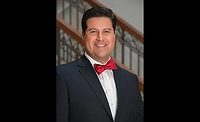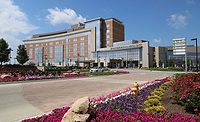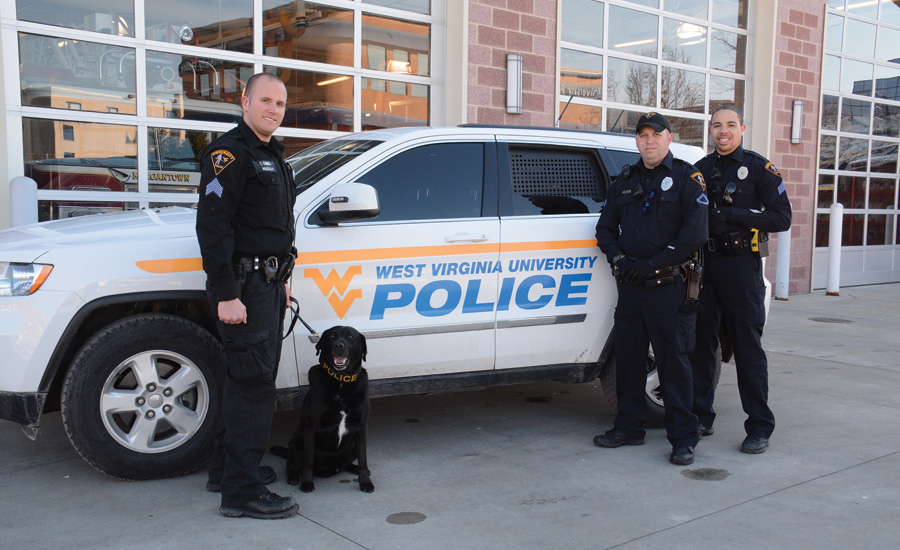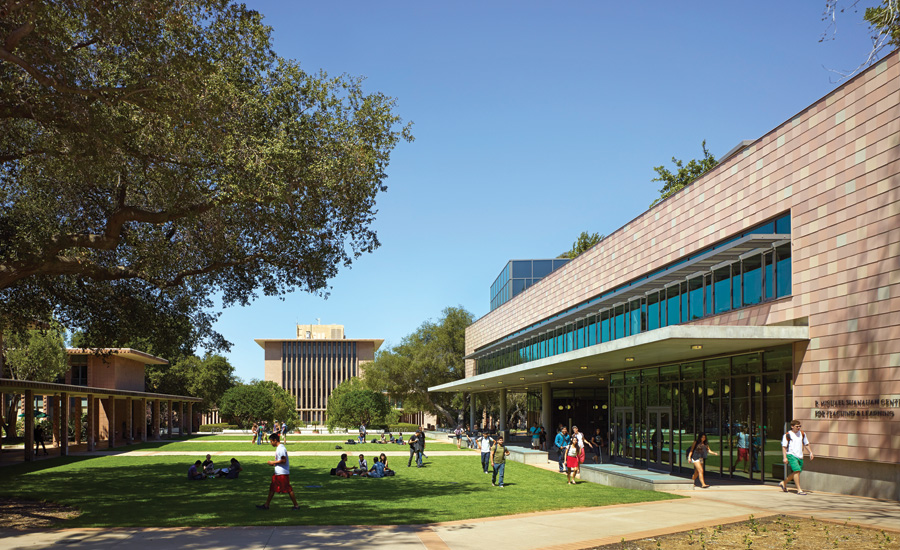Campus Security Moves to the Fore at Colleges and Universities
Mass shootings, terrorism and campus carry all top of mind for security personnel.

West Virginia University has seen an uptick in domestic assaults and battery and just rolled out a new program called Preventing Aggression and Violence Through Education. The program emphasizes principles like the prevalence of alcohol abuse tied to such incidents and the need for proactive and sensitive outreach to the victims. Photo courtesy of West Virginia University

In addition to forging strong partnerships among his seven institutions, Claremont University police work to ensure that the Claremont consortium’s schools are well tied into local police departments, in part because California state law does not allow private colleges and universities to have sworn officer departments. Photo courtesy of Claremont University

The Claremont University Consortium is among those that use the LiveSafe app for emergency notification. Students can provide pictures or audio to law enforcement when they notice suspicious activity, or they can ask to be tracked from point A to point B to make sure they arrive safely, and the app uses GPS to make that happen. Photo courtesy of Claremont University

The New Jersey Institute of Technology has piloted in its library a Panasonic facial recognition system called Face Pro, which attempts to match incoming faculty, staff and students against a database of “good guys” and a list of about 200 “bad guys,” says Robert Gjini, assistant vice president of facility systems. If the system recognizes a “bad guy” that triggers an alarm, and officers can respond and see if it’s an accurate match, he says. Thefts from the library dropped from 11 the year before deployment to zero since then. Photo courtesy of Robert Gjini

“In the competitive marketplace, schools have not wanted to emphasize issues of safety and security,” says James Moore, Senior Advisor for Clery Act Compliance and Campus Safety Operations with the U.S. Department of Education. “But they now realize these things are so upfront – there’s always something in the news about a campus safety issue or identity theft problem – schools have had a change in incentives. … I wouldn’t call it a renaissance because I’m not sure it was there the first time, but [awareness and response] has accelerated.” Photo courtesy of James Moore





College campuses historically have been shy about emphasizing their security policies and procedures, not wanting anxious parents or prospective students to think that a visible security force, camera equipment or other evidence of being watchful means their students are particularly vulnerable.
But over the past decade, with the uptick in mass shootings that truly hit home in 2007 with the Virginia Tech tragedy and broader fears of terrorist incidents, that reluctance has given way to the need for reassurance – because no one is under the illusion that college campuses are somehow insulated from the wider world.
“In the competitive marketplace, schools have not wanted to emphasize issues of safety and security,” says James Moore, Senior Advisor for Clery Act Compliance and Campus Safety Operations with the U.S. Department of Education. “But they now realize these things are so upfront – there’s always something in the news about a campus safety issue or identity theft problem – schools have had a change in incentives. … I wouldn’t call it a renaissance because I’m not sure it was there the first time, but [awareness and response] has accelerated.”
Due to the increased sense of threats, campus security in many locations has been upgraded. When Col. Bob Beach, chief of police at Longwood University in Farmville, Virginia, first thought about taking his current position after nearly four decades in other areas of law enforcement, “We saw campus safety and campus security as one step above mall cops,” he says. “Campuses were kind of lenient.” But not as much now.
The division of DOE for which Moore works provides presentations and general advice. “When we go out to campuses, we talk to officials and very often we can persuade them to make changes,” he says. “We can be a catalyst and help get things done that have been ignored for years.”
For example, it’s not uncommon to find a water treatment facility with a waist-high fence that can be easily breached by a bad actor with benzene. And in an effort to be environmentally friendly, some campuses have installed lighting “with so few lumens that they don’t actually illuminate anything,” Moore says. “We say to schools, ‘They may not work.’ ”
College campuses typically do a better job of community policing than municipal departments simply because of the inherently tight-knit nature of their communities, says Randy Burba, chief of police at Chapman University in Orange, California, and president of the International Association of Campus Law Enforcement Administrators (IACLEA).
“We’ve got increased violence in general, and you’re seeing a lot of media coverage,” he says. “Statistically it’s pretty small, and still less frequent than in society in general, but that doesn’t mean you shouldn’t be prepared to respond.” And he could never have anticipated that his university would be hosting a vice presidential debate, as it will be this October. “It keeps you on your toes,” he notes.
While few campuses see politics that up-close and personal, security personnel need to keep in mind that their backyards will always be places where contentious societal issues are debated, Burba says. “Campuses are where people to go express their opinions, go to learn, where young people are becoming adults and forming their stances on things,” he says. “We always have to be cognizant of that.”
That set of issues is especially relevant during a heated political season, says Stan Skipworth, director of campus safety for the Claremont University Consortium, which includes seven independent colleges and universities in southern California.
“We have a very tenuous climate right now, with a variety of concerns from a national as well as a global perspective,” he says. “We’re now rapidly approaching the final laps of a presidential campaign that has gotten an awful lot of passionate interest on either side of the political spectrum. That passion is traditionally and will continue to be intensely represented across college campuses this fall.”
Campus security personnel can’t and shouldn’t try to control such activity, but they can help to manage and guide the energy and momentum it generates, Skipworth says. “We need to find a common ground where they can accomplish their goals in their demonstration,” he says.
One of the challenges that campus security face in whatever they do is that one-quarter of their student population turns over every year, says David Taylor, associate director of environment and safety services at Gettysburg College in Gettysburg, Pennsylvania. “You’ve got to keep up,” he says. “Probably the most challenging aspect is keeping up with training compliance.”
Array of Threats
Foremost on the minds of campus security personnel are threats of violence ranging from lone gunman active shooters to broader terrorist incidents. Moore says that schools sometimes think they’re better prepared for such scenarios than they actually are. “Schools will tell us they have a lockdown procedure, but when they start describing it, it doesn’t look at all like a lockdown,” he says.
Colleges and universities need to tailor their plans and procedures based on size and layout, as well as campus culture, Burba says. “If I have a school that’s a nice square, you can push a button and [lockdown] makes sense, but many campuses are spread out like small cities, and there’s no way to lock down the entire campus,” he says. “It’s important to educate faculty, staff and students on what to do. For many years, schools struggled to get that [training] in front of people, but those barriers are coming down very, very rapidly.”
Chapman University tries to educate “clumps” of faculty, staff and students at one time with the end goal of making run-hide-fight a second nature response, Burba says. He tells trainees: “I don’t want you to worry about active shooter or campus violence every day. But I want you to have muscle memory or training to respond.”
Campuses are communities unto themselves and need more rapid response than municipal departments can sometimes provide, given that active shooter events typically unfold in five minutes or less, Beach says.
“Whatever life-saving you do, whatever ability you have to mitigate that event, is based on what you have on the scene at the time, not what you call to the scene,” he says. “The only way I’m going to be able to meet an active shooter threat or a terrorist threat … is if I have a highly capable group with constant training and constant maintaining of those skills.”
The other piece, Beach says, is educating students, faculty and staff in the run-hide-fight method of responding to threats of violence, which his department does three times per year. “It’s an interactive thing, with role-playing – if you’re in a work space or a particular area, what would you do?” he says.
High Point University in High Point, North Carolina, has conducted an exercise in which an actor came out to campus and fired a rifle, says Gus Porter, environmental health, safety & preparedness manager. “The response capabilities played out from there,” he says. “The university stood up an emergency operations center, public safety pieces played their role in the response, and the university was able to practice the transition from response to recovery.”
Gettysburg College has twice brought in the FBI to conduct trainings, Taylor says. “The past couple of years we’ve been telling people to shelter in place during these incidents but not really saying what that means,” he says. “We’re telling our community what happens when we activate the notification systems and you’re getting those texts.”
Concerns about domestic and international terrorism require campus security to work with not just local law enforcement but also national players like the FBI, Skipworth says, adding that he and his counterparts have a responsibility to stay on top of the best sources of information.
“We’re working with an awful lot of our state and national law enforcement agencies,” he says. “It’s important for us to work with these different partners in making sure that when we have activities or behaviors reported to us, we share them with individuals at the state or national level, get on their radar, discuss this with them and get more information.”
Campuses that often host large events like sporting contests, rock concerts and the like need to be up to speed on considerations like crowd control and parking, Moore says. The DOE works with them to ensure they are accounting for all the possible risks, up to and including terrorism. “How would you sensibly evacuate a 50,000-seat concert arena quickly and easily?” he says.
West Virginia University sometimes has as many as 60,000 people at football games, says Bob Roberts, chief of police on the Morgantown campus. “We have to look at all the security and the incidents that can happen at those events, with people who aren’t from the campus, necessarily,” he says.
The threat of campus violence has led some state legislatures to allow for campus carry of firearms, which security departments have needed to figure out how to handle in their own fashion. Burba notes that the issue often turns into a broader debate about the Second Amendment but says campus security needs to put the politics aside. “What are the best practices? That conversation is still ongoing,” he says.
In California, the legislature passed a law last year that increased the requirements for campus carry to include the need for written authorization from campus law enforcement, Skipworth says. “While somebody may have been granted the ability to carry a concealable firearm [by the state], that doesn’t guarantee them the ability to bring it wherever they want,” he says.
West Virginia passed a law allowing concealed carry but gave universities the ability to restrict them on campus, which Roberts says the state university campus has chosen to do. “We’re not real sure how it’s going to affect us,” he says. “We’ve encountered people with firearms more than we did prior to its being passed.”
Longwood University does not allow guns on campus but will store them for people who carry while they’re on campus, Beach says. “I’m a lifetime NRA member; I’m a big Second Amendment guy,” he says. “But I’m reasonable enough, and I’ve been around young people enough, to know that I don’t necessarily want a whole bunch of people who don’t have the training, or don’t have the maturity, to have a gun in a crisis situation.”
Gettysburg College also does not allow weapons on campus and even requires that off-duty law enforcement officers announce themselves if they’re going to carry, Taylor says. “We don’t prohibit them if they are law enforcement,” he says. “But you get just one person in a suit with a gun under it, you get calls from all over campus. It saves us a lot of grief” to know in advance.
Given its particular location, Gettysburg also allows campus carry for one other purpose: the many Civil War demonstrations enacted in history classes and student club meetings. “It is a unique Gettysburg thing to think about,” Taylor says with a chuckle. “We got a call about a guy in the history building with a rifle. They failed to tell us it was a guy dressed as a Union soldier. … Some people don’t know weapons from one [period] to the other. I’d rather have them call.”
Beyond gunmen and terrorists, campus law enforcement has been called upon to stem the tide of another type of campus violence: sexual assaults. Given the studies showing “staggering” percentages of women who have experienced these assaults and the legislation designed to combat it, campus law enforcement must work with partners like local law enforcement, anti-rape advocates and student health centers to do so, Burba says.
“It takes a concerted effort to address those issues,” he says. “The biggest thing is to educate yourself as to what the national legislation is … and then knowing state and local laws and those intersect. It’s important to communicate, build partnerships and coalitions, and avoid several interviews of the victim where you end up retraumatizing them.”
West Virginia University has seen an uptick in domestic assaults and battery and just rolled out a new program called Preventing Aggression and Violence Through Education, Roberts says. The program emphasizes principles like the prevalence of alcohol abuse tied to such incidents and the need for proactive and sensitive outreach to the victims, he says.
Access, Surveillance and Notification
To keep tabs on all of these threats, campuses need to strike a balance between being the open environment that people ideally would like while controlling access and watching surroundings to maintain the peace, Moore says. “People want to be part of an open community, but what about the liability that might come with allowing people just to come on and off campus, not knowing who might be within your boundaries,” he says.
One example of a campus-specific reason for that is the security of research, especially controversial research. “There are schools that do animal research. There are people who don’t like that,” Moore says. “That one camera on the lab door isn’t enough. They’re doing sophisticated things with ground sensors, making sure their labs are secured.”
Access control has been a major and ongoing issue at High Point University, which has boomed in the past decade to 4,500 undergraduate students, with 700 more expected in the next three years, and more than 400 acres of space that’s increasingly not contiguous to the central part of the campus, says Lindy Johnson, manager for security technology and communications.
Partly because the campus is “not in the best section of High Point,” the school elected to fully enclose the main campus with a brick and iron fence, and every entrance now has a welcome center with a mobile observation post that’s staffed 24/7, with an ID card, car decal or visitor registration required after 8 p.m., she says. The campus has 550 card access doors and 850 cameras, and those numbers will reach 700 and 1,000, respectively, before long.
High Point also has ramped up the RAM and cache of its video system to extend the storage window, while training dispatchers to do video review so that investigators “don’t spend all day staring at video,” Johnson says. “Because of our robust video system, students, staff and faculty expect us to solve whatever’s going on,” she says. But that’s challenging as video locations expand.
For most of Taylor’s 32 years at Gettysburg College, the campus had a 24/7 open environment, but that’s changed, he says, with requirements for card access, increased numbers of cameras starting with parking lots and moving into buildings, and closed-circuit television to keep watch. The latter has been especially helpful with parking lot vandalism, which used to happen at an epidemic rate of 30 to 40 incidents per weekend but has practically disappeared, he says.
“Almost all the buildings have card access,” Taylor says. “Closed circuit television is in more targeted areas like throughout the administration building, through the library, hidden ideas in the bookstore, the art gallery, places that are high value. We’re just now starting to look at the inside of classroom buildings and dorms.”
Longwood had zero video surveillance nine years ago when Beach joined the force; now, the campus has 300 cameras, he says. “That’s a force multiplier,” he says. “There’s a lot of smart things you can do with analytics.”
At Cairn University in Langhorne, Pennsylvania, all students and employees have ID cards that double as access control for all on-campus and some off-campus buildings, says Christopher Lloyd, director of the office of safety and security, as well as secretary of the Northeast Colleges and Universities Security Association (NECUSA).
New Jersey Institute of Technology (NJIT) has piloted in its library a Panasonic facial recognition system called Face Pro, which attempts to match incoming faculty, staff and students against a database of “good guys” and a list of about 200 “bad guys,” says Robert Gjini, assistant vice president of facility systems. If the system recognizes a “bad guy” that triggers an alarm, and officers can respond and see if it’s an accurate match, he says. Thefts from the library dropped from 11 the year before deployment to zero since then.
More broadly, NJIT has doubled its Newark campus to 3.5 million square feet over 45 acres during the past 20 years, a pace that has been challenging to keep up with, Gjini says. “If you’re responding to 100 different doors that have alarms and then expand that to 200, your false alarm rates go up, officers get desensitized and you try to keep it manageable, which is sometimes a challenge,” he says. There are currently 160 card readers, he adds.
Mass notification systems including applications that run over mobile devices also have become prevalent in recent years on college and university campuses. “That’s only a natural progression that speaks to what to do in the case of an active shooter,” Burba says. “They can push one-button 911. They can send an anonymous text. It’s too obvious to pick up the phone and call [when observing a suspicious person], but it’s doesn’t look suspicious for a 20-year-old to be texting.”
The Claremont University Consortium is among those that use the LiveSafe app for emergency notification, Skipworth says. Students can provide pictures or audio to law enforcement when they notice suspicious activity, or they can ask to be tracked from point A to point B to make sure they arrive safely, and the app uses GPS to make that happen.
Highpoint can notify its campus constituencies through both old school means like four outdoor siren public access systems as well as newer methods like text, e-mail, and social media, Porter says. The campus also has added the LiveSafe app, which has helped to lower the barrier for communication with law enforcement.
“We’re a big fan of LiveSafe,” he says. “Students are more comfortable reporting anonymously. We are very eager to take those reports. … Any way to have more information about what’s happening on campus and what concerns students have is of definite interest to our department.”
West Virginia also uses LiveSafe, which Roberts lauds as “an excellent community policing tool. It allows the community who use the app to send information into our communications center. If they see lights out, they can take a photo of the area, the light post and its number, and send them to us. Or if they see people arguing and fighting, they can send that [information] to us directly.”
Forging Partnerships
Whatever remedies colleges and universities come up with to keep their campuses safer, they need not go it alone – and should not, Moore says. Partnering with all levels of government on various pieces of their security protocols is the only feasible way to go, given the “nobody has all the resources on their own,” he says. “How will it look in the media if you haven’t tied into the county or state [notification] system and God forbid you have an active shooter incident?”
In addition to forging strong partnerships among his seven institutions, Skipworth works to ensure that the Claremont consortium’s schools are well tied into local police departments, in part because California state law does not allow private colleges and universities to have sworn officer departments. He hopes that will change legislatively, but in the meantime “it forces many private schools to work much more dependently and directly with local law enforcement,” he says.
High Point has worked to forge strong relationships with both the municipal police and its counterparts at the local University of North Carolina campus, Johnson says. “They regularly participate with us in full-scale exercises,” she says. Porter adds that the main campus is ½-mile from both police and EMS and ¼-mile from the nearest fire station. “It’s a nice location to get public safety response,” he says.
Given that its campus doubles the population of Farmville, Va., Longwood University has developed a joint jurisdiction with the town to combine training and execution efforts, Beach says. “We help them with calls for service,” he says.
Cairn University works with local police, fire and EMS to train its patrol officers, most of whom are students, Lloyd says. “We’re probably one of the few campuses that uses students as patrol officers,” he says. “We can’t put them in harm’s way, but at the same time we’re asking them to protect the campus.”
This has meant very close tie-ins with local law enforcement around everything from drug training to active shooter response. “We have a good working relationship with them, but we’re still using students to protect students,” Lloyd says. “God forbid one of them gets hurt doing that.”
Campus Identity Theft Another Threat to Track
Another threat vector that college campuses haven’t necessarily focused on enough is student identity theft, which can be carried out through the “smart cards” given to students to pay tuition, buy food and interact financially with their institution in other ways, says James Moore, compliance officer with the U.S. Department of Education.
Often schools enter into agreements with banks or technology companies to operate these systems but don’t attend to security issues, although that’s beginning to change, Moore says. However, in some cases they don’t realize how weak their cybersecurity is until they attempt to enter into a contractual agreement with a federal agency, which then balks.
“The Navy says, ‘Oh no, we can’t enter into an agreement with you,’ ” he says. “That prompts them to look at the smart cards and research their agreement. What if that stuff gets hacked? What if it gets compromised from the inside? Schools realize, ‘We didn’t think about the saboteur that comes at us from the inside.’ ”
Cairn University in Langhorne Manor, Pennsylvania, has built a secure firewall configuration and has trained people on campus about phishing scams at least a couple times a year to make sure they are aware of the dangers, says Curt Winters, director of information technology. “That’s my weakest link and greatest fear,” he says, adding jokingly: “Those who click on these links, we take them out back and beat them up.”
Another cybersecurity issue that “makes the hair on the back of my neck stand up” is cloud storage, Winters says. “It involves a lot of training and protocol as to what we want to store out there.” The university uses Google Drive for collaboration and it works well for that purpose, but “my position is that we cannot store anything out there that we would not want publicized,” he says. “What happens if somebody says, ‘This is old data, it’s no longer relevant, we don’t need to protect this anymore?’ ”
Looking for a reprint of this article?
From high-res PDFs to custom plaques, order your copy today!










